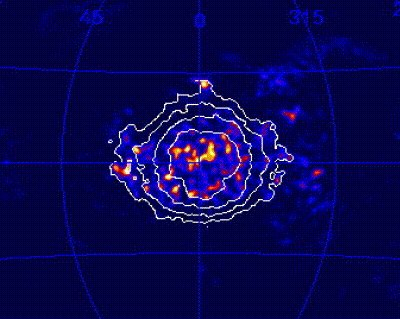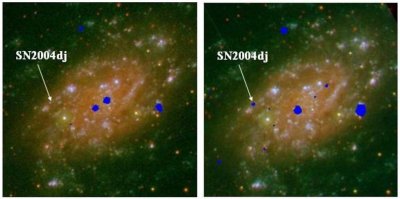Viewing the High-Energy Universe
9 November 2004
ESA's two high-energy astrophysical observatories have produced new views on some of the extreme events at work in the Universe. INTEGRAL observations of the galactic plane reveal some indications on the distribution of matter and antimatter, while XMM-Newton has observed an X-ray afterglow to a supernova explosion in NGC 2403, just 11 million light years away.Integral View of Galactic Centre
 |
|
Credit: J. Knödlseder (CESR) and SPI team |
The SPI instrument onboard INTEGRAL has performed a search for 511 keV emission (resulting from positron-electron annihilation) all over the sky. The image above represents the results of this search: the all-sky map in galactic co-ordinates shows that 511 keV emission is - so far - only seen towards the centre of our Galaxy. The SPI data are equally compatible with galactic bulge or halo distributions, the combination of a bulge and a disk component, or a combination of a number of point sources. Such distributions are expected if positrons originate either from low-mass X-ray binaries, novae, Type Ia supernovae, or possibly light dark matter.
XMM-Newton Spies Supernova
 |
|
Image courtesy of Pedro Rodriguez and ESA |
The supernova SN2004dj was discovered on 31 July 2004 by Koichi Itagaki (IAUC 8377) within the compact star cluster Sandage 96 in the galaxy NGC2403. The supernova has since evolved with a Type II-P light curve. The progenitor is currently thought to be a 15 solar mass blue supergiant.
The left panel in the above image shows an XMM-Newton observation in 2003. The image is colour coded, the red channel contains the DSS image, and the green and blue channels contain, respectively, the data from the simultaneous Optical Monitor exposures, in the UVW1 and UVW2 filters. The X-ray sources found in the pn map are added as saturated blue regions. In the right panel, following a Target of Opportunity (ToO) request on 2 August 2004, SN2004dj was observed by XMM-Newton on 12 September 2004. The Supernova appeared in the EPIC PN image as a new source (blue).Preliminary analysis of the ToO data shows the presence of an X-ray source (pn) as well as UV source (OM UVW1,UVM2, UVW2) at the SN2004dj location within the XMM-Newton astrometric accuracy (2-3 arcsec). The average count rate during the pn exposure was 0.012 counts per second, which roughly corresponds to a flux of ~2x10-14erg/cm2/s.
